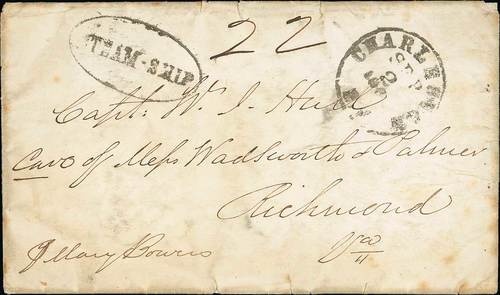
Auction: 17025 - Bermuda, Crossroads of the Atlantic: A Postal History from 1617 to 1877 - The David Pitts Collection
Lot: 33
(x) Military Mail
The strategic importance of Bermuda had been apparent from the 18th. Century. In 1795, after the Revolutionary War, the British restored bases its bases on the American continent though it wasn't until the War of 1812 that there was a significant increase in the British naval presence on Bermuda. She became the winter home of the Atlantic fleet and the principal naval port between Halifax and the B.W.I. Halifax was the fleet's summer home
The American Civil War Blockade
During the American Civil War, the North sought to cut off the South from its cotton markets with Europe with a blockade of the Atlantic Coast. Initially unsuccessful, as the War progressed contravention became more effective. To circumvent the blockade the South used small, fast boats known as "blockade runners". From Bermuda these letters would be carried either by private ship direct or packet via Halifax. Most mail through Bermuda used Wilmington, North Carolina
1864 (24 Aug.) entire letter from St. George's "p Mary Bowers" (wrecked on her approach to Charleston) to Capt. Hull care of Messrs. Wadsworth & Palmer at Richmond, Virginia", rated "22" (2c. ship fee +double 10c. Confederate postage) and showing oval-framed "steam-ship" handstamp and Charleston (2.9) datestamp. The only recorded blockade runner wreck cover and the only blockade runner cover to Charleston originating in Bermuda. One of just eleven blockade runner covers originating in Bermuda. Photo
Note: The "Mary Bowers" was most unusually wrecked upon the wreck of a previous blockade runner, the "Georgiana", as she approached Charleston, having pretended to be bound for Halifax. She was a total loss although there were no casualties with the crew and passengers escaping ashore with the mailbag and reaching Charleston where they delivered the mail on 2 September. One boy, accidentally overlooked and left behind, was picked up the next day by the USS "Wamsutta" which was investigating the area
literature:
"Maritime Disaster Mail" by Hoggarth and Gwyyn, pages 42-43 where this cover is illustrated
provenance:
Morris H. Ludington, June 1999
Subject to 5% tax on Hammer Price in addition to 20% VAT on Buyer’s Premium. For more information please view Terms and Conditions for Buyers.
Sold for
£4,000




